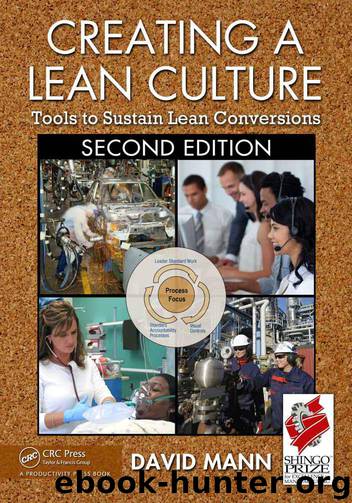Creating a Lean Culture: Tools to Sustain Lean Conversions, Second Edition by David Mann

Author:David Mann [Mann, David]
Language: eng
Format: mobi
Publisher: Productivity Press
Published: 2013-03-03T14:00:00+00:00
1 2 3 4 5 6 7 8 9 10 11 12 13 14 15
1 2 3 4 5
ve?
.
't ha
orm
ake the project a success?
lan f
ent
il m
e
ch regarding cause?
es
at ap, and/or text here.
un
m
atem
H
ctiv hat w
Obje
rrent St
't want? What do we want but don
plish? W
Cu
Problem St
roject p
ve but don
-3 p
ying to accom
a
Impact on the business?
Insert picture, value stream
What do we ha
.1a
What are we tr
ct Plan:__________________________________________
pdated __/__/__
A3 Proje
U
figure 9
174 ◾ Creating a Lean Culture
figure 9.1b a-3 project plans of a project plan board. rows one through three on this project board are for each value stream in this plant. row four is for plant projects .
active projects are in columns one and two, on-deck projects and kaizen plans in column three. Plans are reviewed weekly. Weekly milestone due dates are noted in gray. Milestones are coded green when completed, red until completed. a note in the blank spot, upper right, says two on-deck kaizen plans required.
CASE STuDY: WORkInG WITHOuT A
RESPOnSE SYSTEM (nuMBER 1)
The first case occurred, not coincidentally, in the plant where the
supervisor “stored” the production-tracking forms on the floor under
his desk. The lean conversion involved switching from a build-com-
plete process at a number of stand-alone two-person workbenches to
a single progressive build assembly line. In the bench-build process,
a number of subassemblies were produced in batches upstream from
assembly, picked into kits based on a schedule, and pushed up to the
benches. The progressive build line incorporated a number of these
subassembly areas in an integrated takt-paced flow production process.
Signals went out to subassembly production from the single schedule
point in the flow process.
It was extremely rare for production to stop in the bench-build
scenario. There was always the option of working ahead based on
the schedule. And, if one bench experienced problems, it was likely
Solving Problems and Improving Processes—Rapidly ◾ 175
the others could keep on producing while the problem load was
pushed aside and the next one brought in. In the flow process, when
there was an interruption, 13 people stood around waiting for the
problem to be identified and fixed. Two temperamental pieces of
automated equipment were built into the flow process. They failed
repeatedly. Worse, the failures were intermittent.
To the credit of the project team designing the new flow process, they
recognized the need to establish a quick response process and told the
support groups they would need their support in a different and more
timely way than in the past. Maintenance, engineering, and materials
management agreed, and for the first several weeks when the “911” calls
went out, the response was timely. A host of flow interruptions quickly
emerged as the new process began operation. There were frequent mate-
rial shortages outright, and material supply errors resulting in mix-ups in the sequence of parts to the various stations on the progressive assembly
line. There were problems with alignment of parts in assembly that used
to be muscled through at the benches. Now, these problems caused
repeated disruptions in flow at the 36-second takt time. The automated
equipment also failed intermittently, causing further interruptions.
It was a pretty typical startup for a lean conversion. The system
was doing what it was supposed to do, exposing flow interruptions.
Download
This site does not store any files on its server. We only index and link to content provided by other sites. Please contact the content providers to delete copyright contents if any and email us, we'll remove relevant links or contents immediately.
Hit Refresh by Satya Nadella(8856)
The Compound Effect by Darren Hardy(8513)
Change Your Questions, Change Your Life by Marilee Adams(7377)
Nudge - Improving Decisions about Health, Wealth, and Happiness by Thaler Sunstein(7244)
The Black Swan by Nassim Nicholas Taleb(6770)
Deep Work by Cal Newport(6563)
Daring Greatly by Brene Brown(6227)
Rich Dad Poor Dad by Robert T. Kiyosaki(6179)
Principles: Life and Work by Ray Dalio(5962)
Man-made Catastrophes and Risk Information Concealment by Dmitry Chernov & Didier Sornette(5650)
Playing to Win_ How Strategy Really Works by A.G. Lafley & Roger L. Martin(5506)
Digital Minimalism by Cal Newport;(5392)
Big Magic: Creative Living Beyond Fear by Elizabeth Gilbert(5354)
The Myth of the Strong Leader by Archie Brown(5239)
The Slight Edge by Jeff Olson(5200)
Discipline Equals Freedom by Jocko Willink(5157)
The Motivation Myth by Jeff Haden(5005)
Stone's Rules by Roger Stone(4859)
The Laws of Human Nature by Robert Greene(4777)
